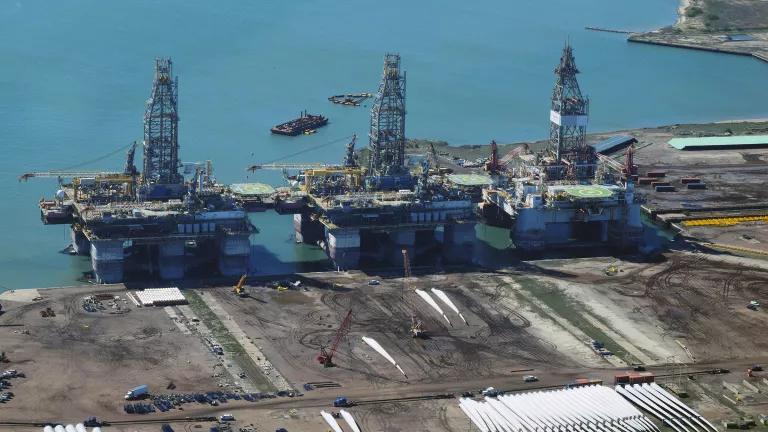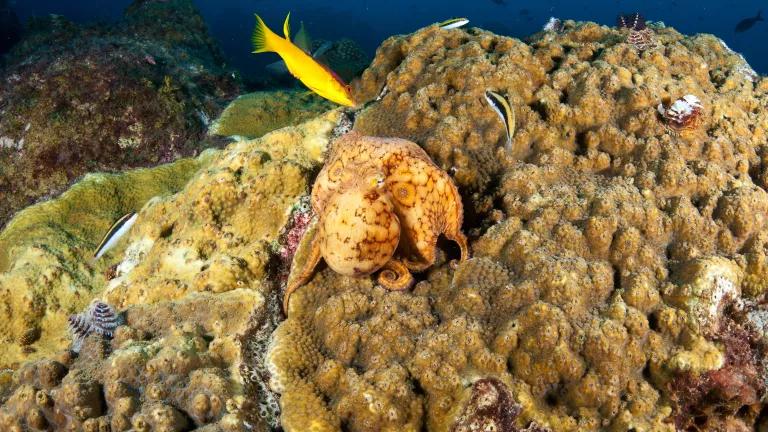Yet Another Oil Spill Hits the Gulf of Mexico
The largest Gulf oil spill since Deepwater Horizon highlights the inherent risks of offshore drilling to coastal communities and marine ecosystems.

Two brown pelicans swim in gulf waters near St. Petersburg, Fla. after being released at the Egmont Key National Wildlife Refuge May 30, 2010. The birds were found oiled near Louisiana's coast following the Deepwater Horizon disaster. An estimated 1 million seabirds were killed by the 2010 oil spill.
Petty Officer 3rd Class Nick Ameen/U.S. Coast Guard
A new large oil spill hit the Gulf of Mexico on November 16. This disaster is a stark reminder of the constant risk that offshore drilling poses to wildlife, ecosystems, and coastal communities. Offshore oil and gas production is inherently risky—as the Gulf knows all too well from the 2010 BP Deepwater Horizon disaster, which killed 11 workers, pumped 134 million gallons of oil into the ocean, and had long-lasting effects on communities, animals, and habitat.
The Coast Guard reported that the recent spill may have released over a million gallons of crude oil in the Gulf, which would make it the largest spill in the region since Deepwater Horizon. On November 16, an oil slick 3-4 miles wide was detected 19 miles offshore Plaquemines Parish in southeast Louisiana. Federal officials have not yet confirmed the source of the spill, but it may have originated from the 67-mile Main Pass Oil Gathering pipeline system, which transports crude oil to shore from seven different offshore drilling operators. However, the Coast Guard has inspected the full length of the Main Pass Oil Gathering pipeline system, along with sections of nearby pipelines, without finding evidence of damage or the cause of the leak.
On December 5, more oil was detected on the water’s surface near the original spill, even though the main pipeline and several others have been shut down since the initial incident in November. The Coast Guard has not confirmed whether the oil releases came from the same source.
Oil spills are an unavoidable consequence of offshore drilling. The Bureau of Safety and Environment Enforcement (BSEE), the federal agency responsible for ensuring safety and environmental protection in offshore oil and gas operations, documented 992 oil spills in U.S. federal waters during 2021 and 2022. These spills released nearly 80,000 gallons of oil. While regulations like the recently-finalized Well Control Rule can help prevent blowouts by requiring the fossil fuel industry to use safety equipment, it is essentially impossible to prevent all oil spills. For the offshore oil and gas industry, they are simply a cost of doing business.
Spills can inflict long-lasting harm on local ecosystems and wildlife, as shown by the catastrophic Deepwater Horizon spill. Oil exposure can smother or weaken the plants that support important habitats like seagrass meadows and coastal wetlands, which play a critical role in carbon sequestration and flood protection, and provide habitat for numerous species. Deepwater Horizon contaminated over 92,000 square miles of surface water and 1,300 miles of coastline. Eight years after the disaster, coastal oil concentrations were still ten times higher than before the spill.
Oil is toxic to animals and can cause mortality from exposure or ingestion. When marine mammals surface in or near an oil slick, they also risk inhaling oil, which can likewise be fatal. The Deepwater Horizon spill killed an estimated one million seabirds and up to 8.3 billion oysters and 5,000 marine mammals. Exposure to oil can kill fish larvae and impair the reproduction capacity of adult fish. After Deepwater Horizon, fishing communities were devastated as the Gulf of Mexico commercial fishing industry lost around $247 million and thousands of jobs.
Alarmingly, oil from the November Gulf spill partially overlapped with the habitat for the critically endangered Rice’s whale—a species of baleen whale that lost nearly 20% of its population as a result of Deepwater Horizon. Rice’s whales live exclusively in the Gulf of Mexico, and there are only about 50 of them left. Although the population still has a chance to recover, oil spills are an ever-present threat to the species' survival.
The newest Gulf oil spill highlights, yet again, the risks that offshore drilling poses to the marine and coastal environment. Ultimately, the only way to protect Gulf wildlife, ecosystems, and coastal communities from oil pollution is to end offshore drilling once and for all.


